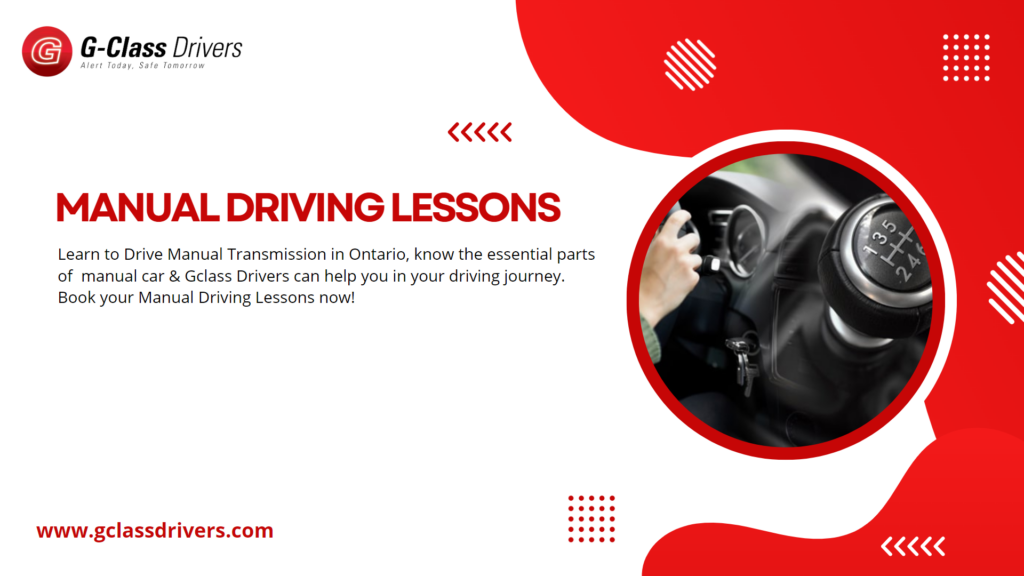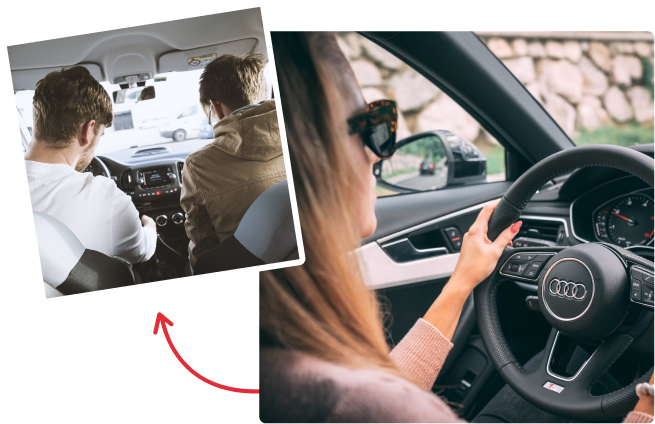If you take manual driving lessons in Ottawa, then it will not be difficult for you to drive anywhere. Although driving a manual car is difficult compared to an automatic, it’s not impossible. The basic thing you need to learn is to manage the process of gears.
Along with familiarizing yourself with the clutch, the gear stick is also very important. You need to know about what gear to change at what speed. If you want to learn to drive a manual car then our simple guide can help you.
Parts of Manual Car
Before manual driving lessons, you need to know the basic parts of a manual car. This will help you while driving. Following are the main parts of a manual car that you need to know during your manual driving lessons:
Shifter
Shifter or gear is mostly located in the middle of the passenger and driver seats. You have to change and select the desired gear while driving. While driving, you will have to change from first to second or third gear, and so on, depending on the speed. Reverse and neutral gears are also present in a manual car.
Clutch Pedal
The Clutch pedal is on the left side next to the brake, operated by your left foot. Clutch pedal is mainly controlled by hydraulics. If the clutch pedal is upward, the manual transmission will be connected to the engine. Due to this, the vehicle is receiving power, and you can’t change the gear. But when the clutch is in a downward position, the car is not receiving power, so you can change gears.
Handbrake
The handbrake is generally located in the center console and is operated by hand. Sometimes, the handbrake is located at the bottom near the floor to be operated by foot. But do not confuse the parking brake with the brake pedal.
Both are different; the handbrake is used when the car is in neutral and the brake is not pressed. This keeps the vehicle from moving backward and keeps the car stationary.
How To Drive a Manual Car?
Yes, in this era driving a manual car may seem challenging. At first you will be nervous, but with practice, you’ll master it as soon as much you practice. However, keep in mind the basic steps that are involved in driving a manual car.
Below is a simple, step-by-step guide to help you understand the process and make driving a manual car easier.
1. Knowledge of Basic Controls
For driving a manual car you should have the knowledge of basic controls. These controls are very important to learn as your driving and life depend on them almost.
- Clutch Pedal: The leftmost pedal is used to disengage the engine from the transmission.
- Brake Pedal: The middle pedal for slowing down or stopping the car.
- Accelerator (Gas Pedal): The rightmost pedal is used to control speed.
- Gear Stick: The lever used to change gears.
- Parking Brake: A handbrake is used when the car is parked or when stopping on a slope.
2. Monitor the Car
Before you start the car, observe the car. Make sure everything is alright, and tires, mirrors, and other systems are working properly. As a new driver also consider the things like your route is clear.
3. Make Sure the Car is Neutral
Make sure your car is in neutral gear. Sit in the driver’s seat and ensure the gear stick is in neutral (the middle position). Bring the gear to the neutral (N) position. If it doesn’t, ensure the gear selector is in the middle.
4. Wear Seatbelt
The seatbelt is life-saving. So you have to wear the seatbelt at every cost. Not wearing a seatbelt can lead to accidents and you can also caught by the police.
5. Adjust Seat Position
Adjust seat position to fully access the clutch pedal’s range of motion, allowing full press of the left pedal to the floor with the left foot.
6. Press Clutch Pedal
Our next step will be operating the car. Place your foot on the clutch. Then press the clutch pedal down to the floor carefully. Don’t be so hasty or harsh.
7. Safety Check
To ensure neutrality, move the gear selector to the middle of the stickshift boot, and wiggle it back and forth. Then check if the stickshifter moves freely, and press the clutch pedal to the floor.
8. Start the Car
To start a vehicle, locate the ignition, usually next to the steering column. Turn the key or press the start button to start the car’s engine. To start the vehicle, turn the ignition to the halfway position, fully press the clutch pedal, and set the gear selector to neutral.
9. Disengage Parking Brake
To move forward in a manual transmission vehicle, disengage the handbrake. Check the owner’s manual for electronic handbrakes, as they may not appear. Disengage the handbrake on a level surface and cover the brake pedal.
10. Get Ready for Moving Forward
Starting the vehicle, take a deep breath, count to ten, and relax your muscles before driving a manual transmission. Ensure your seat belt is on and adjust the seat to the most comfortable position.
11. First Gear
Keep the clutch still pressed and move the gear stick into the first gear. Keep your foot on the clutch while you get ready to release it gradually.
12. Start Moving Slowly
Slowly begin to release the clutch pedal while pressing the accelerator gently. Don’t be hasty or nervous. You’ll feel the car start to move as you release the clutch. Press the accelerator more as you move forward to prevent the engine from stalling.
13. Shift Gears
Once the car is moving and you’ve gained speed, it’s time to shift gears. Press the clutch pedal down again and move the gear stick to the next gear (second, third, etc.). Gradually release the clutch and press the accelerator to maintain speed. Don’t go with more speed as a new driver keep it minimum.
14. Slowing Down
When you want to slow down, ease off the accelerator and press the brake pedal. As the car slows, press the clutch and shift into a lower gear to match your speed. If you’re coming to a stop, shift the gear stick to neutral and apply the parking brake.
15. Stopping the Car
To fully stop, press the clutch pedal, move the gear stick to neutral, and gradually press the brake pedal until the car stops completely. Apply the parking brake before turning off the engine.
16. Reversing
To reverse, press the clutch pedal and move the gear stick into reverse gear. Slowly release the clutch while lightly pressing the accelerator to move backward.
How To Avoid Damaging the Clutch?
During your manual driving license, Hamilton, you will also be taught to avoid damaging your clutch. With time, you will learn how to handle the car’s clutch and know where the car’s bite point is. Over time, you will understand how many revs you need to give the car to move off.
If you are not careful, your car’s clutch can wear out in no time, which could cost you a fortune. Although it does sound complicated, all you need is practice.
Manual driving lesson tips can help you avoid damaging your clutch. Remember not to use a clutch to hold your car at hills or junctions. If you are at a junction or in traffic, use hand brakes instead of putting your foot on your clutch pedal. Try to keep revs to a minimum, as it causes unnecessary wear on clutch plates.
How Many Gears Does a Manual Car Have?
Years ago, manual cars had four gears, but nowadays, most cars have at least five gears. Although some cars also have six gears, which is becoming increasingly popular. With the sixth gear, it’s easy for the engines to run more during motorway cruising. This, in return, also reduces fuel consumption and saves money.
Benefits of Driving a Manual Car
Driving a manual car has a lot of advantages over the automatic car. Manual driving lessons can greatly improve your driving skills. Following are some of the benefits of driving a manual car:
Lower Price
Manual transmission cars are a lot cheaper as compared to the automatic transmission cars. Due to fewer moving parts manual cars cost less. If you want to buy a car and are on a tight budget, then it’s better to buy a manual car.
Better Gas Mileage
When you drive a manual transmission car, you are in charge of the car. You shift the gears depending on the requirement, deciding how much power you want to send to the engine. For instance, when you are going down the hill you can change the gear to neutral, thus saving fuel.
Lower Repair Cost
There are fewer parts in manual transmission cars as compared to automatic cars. That is why the repair costs will also be lower.
How Can G-Class Drivers Help You?
With experienced instructors, “G-Class Drivers” driving school can provide you with the best manual driving lessons. Our trained and experienced instructors will guide you till the end. They will help you improve your driving skills and will also identify improvements you need. Our driving school manual can help you improve your skills. Learning to drive a manual car needs practice and time. Our instructors can help you, so what’s the wait for? Contact Gclass Drivers if you want to learn to drive a manual car.
Conclusion
To conclude, manual driving lessons can effectively increase your driving skills. If you want to drive a car manually, then getting these lessons is necessary. You will also learn about the basic parts of a car, which include clutch, gear, and hand brakes. Learning about these 3 is necessary before driving a manual car. This manual car also has a lot of advantages over the automatic transmission car. Gclass Drivers are here for your help till the end. From the very start of driving a car to the end of getting your license, you will get all the help you need from us. So what are you waiting for?
FAQs
How do you drive a manual car for beginners?
To drive a manual car, start by pressing the clutch, shifting into first gear, and slowly releasing the clutch while pressing the gas pedal. As you gain speed, shift gears up when needed, always pressing the clutch before changing gears.
Are manual cars easy to drive?
Manual cars can be challenging at first, but with practice, they become easier to drive. The key is learning how to coordinate the clutch, gas, and gears.
What is the trick to driving a manual?
The main trick is mastering the balance between the clutch and gas pedal, especially when starting or stopping. Smooth gear shifts come with practice.
How to brake in a manual car?
To brake in a manual car, press the brake pedal and then the clutch just before stopping to prevent the engine from stalling. You may also downshift to lower gears if needed.
How to change gears in a manual car step by step?
- Press the clutch pedal fully.
- Move the gear stick to the desired gear.
- Slowly release the clutch while pressing the gas pedal.
- Repeat this process as you shift up or down while driving.





